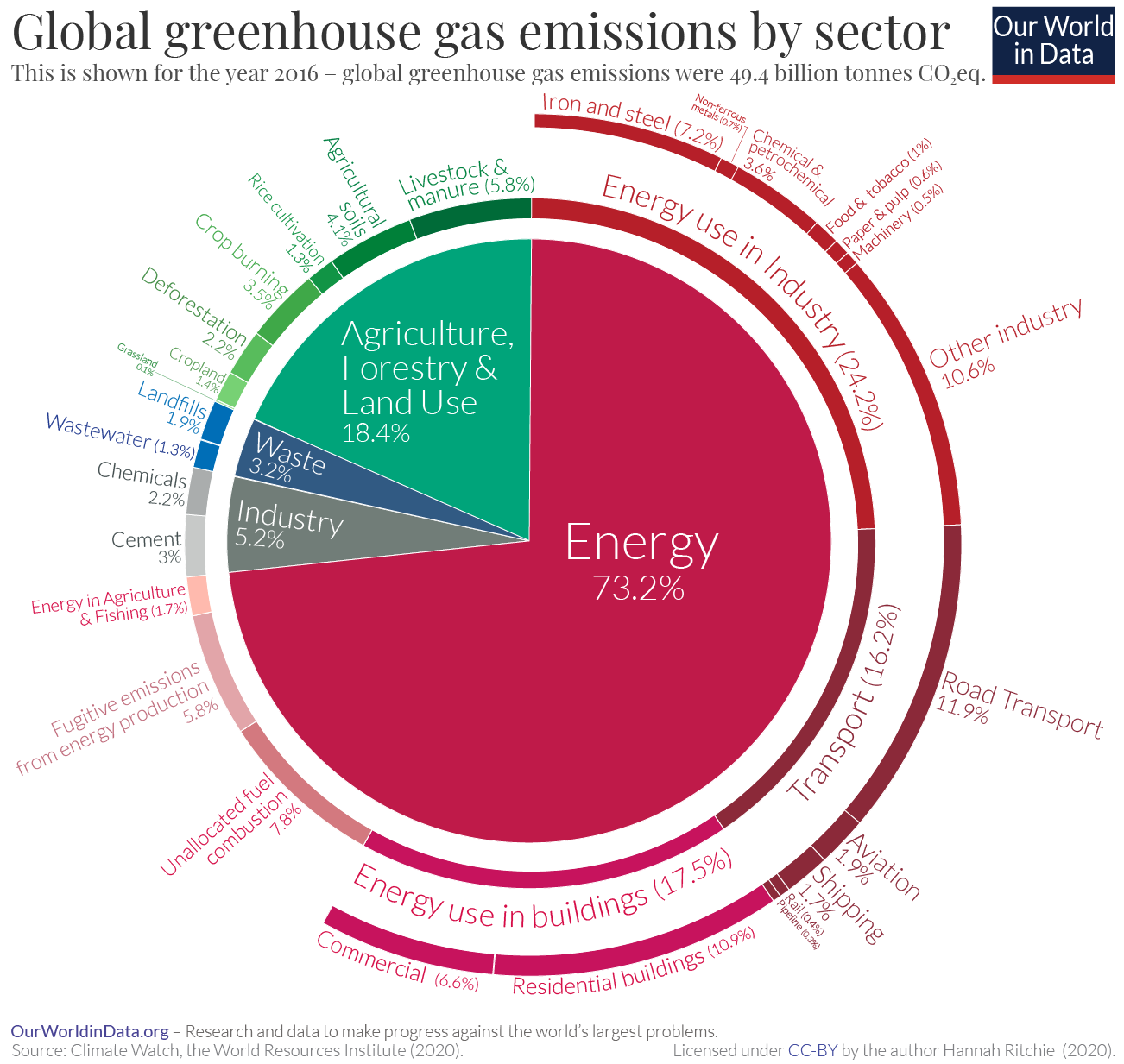Summary
- Greenhouse gas emissions are driven primarily by human activities across various sectors like energy, agriculture, and industry.
- Identifying the largest emitting sectors is essential for developing effective mitigation strategies, as tailored regulations can guide international efforts to reduce greenhouse gas emissions and combat climate change effectively.
- The transportation sector significantly contributes to greenhouse gas emissions from road, aviation, and maritime activities, necessitating effective strategies to mitigate environmental impacts and promote sustainable practices amid rising global demand.
Introduction
Greenhouse gases (GHGs) are substances in the Earth's atmosphere that trap heat. These gases, including carbon dioxide (CO2), methane (CH4), nitrous oxide (N2O), and fluorinated gases, create a natural greenhouse effect, crucial for maintaining the planet's temperature. However, human activities have significantly increased the concentration of these gases, exacerbating global warming.
Understanding and mitigating GHG emissions are paramount in addressing climate change. The intensification of the greenhouse effect has contributed to rising temperatures, extreme weather events, and ecosystem disruptions.
Various sectors contribute to GHG emissions, each with its unique impact. These sectors include energy, transportation, agriculture, industry, and more. Breaking down global greenhouse gas emissions by sector and identifying the largest emitters is vital for implementing targeted emission reduction strategies and policies.

Fig. 1: Taken from OurWorldInData.org, licensed under CC-BY by author, Hannah Ritchie
Importance of Identifying Greenhouse Gas Emissions by Industry
Determining the largest emitting sectors is crucial for understanding their environmental impact. Some sectors can release more potent greenhouse gases, depending on the degree of mechanisation or pollutants involved in production of goods and services.
For example, capital goods used in specific industries such as tractors in farming might not be as relevant in automotive manufacturing, making blanketed approaches towards regulating multiple industries using similar restrictions unproductive. Such nuances have been influential in guiding public policy, as the international community has recognised the urgency of addressing GHG emissions. Global initiatives and agreements, such as the Paris Agreement, aim to unite nations in the fight against climate change. Breaking down greenhouse gas emissions by sector has shaped international emission reduction efforts.
Global Context: Where We Are Now
The past hundred and fifty years have been marked by an unprecedented wave of industrialisation across the globe. This era of rapid industrial growth, fueled largely by the burning of fossil fuels and technological advances, has significantly contributed to the alarming increase in GHG emissions. This has also had significant impacts echoing through ecosystems and climate patterns.
Only in the past twenty to thirty years, what has emerged is a notable increase in global awareness and an attentiveness to the lopsided emission patterns of specific sectors. Individuals, corporations, and governments have acknowledged the imperative of combating climate change. Whether it be global, national, or communal, movements have sprung up around the world and propelled the urgency for immediate action to reduce GHG emissions.
Regulations too have come under scrutiny for not doing enough. As such, further efforts across the world have seen phased-in approaches levying direct and indirect regulation of emissions, aimed at transitioning higher emissions-intensive sectors towards carbon neutrality.
Breaking Down the Biggest Greenhouse Gas Emitting Industries
Climate change is undeniably linked to the rise in GHG emissions, predominantly driven by human activities. Understanding the sectors responsible for the lion's share of these emissions is crucial for developing effective mitigation strategies. This comprehensive exploration delves into the major contributors to GHG emissions, assessing the impact of each sector and examining potential mitigation measures.
A. Energy Sector
Fossil fuel combustion stands out as a critical emission hotspot within the energy sector, representing a significant contributor to GHG emissions. This process involves the burning of fossil fuels, releasing substantial amounts of CO2 and other pollutants into the atmosphere. The overall dependence of global logistics on fossil fuels and flagging global coordination on regulation has meant that this will continue to be a reality for several more decades. Among the primary emission drivers in this category are coal, oil, and natural gas, each with distinct environmental implications.
Coal: As one of the most carbon-intensive fossil fuels, the burning of coal for electricity generation and industrial processes releases significant quantities of CO2, which in turn significantly exacerbates global warming. Despite growing awareness of its environmental impact, coal continues to be a dominant energy source in several regions, posing a considerable challenge for emission reduction efforts.
Oil: Encompassing extraction, refining, and consumption, oil plays a substantial role in GHG emissions. Throughout its lifecycle, from drilling to combustion, oil releases CO2, CH4, and other pollutants. The transportation sector, heavily reliant on oil-based fuels, significantly contributes to these emissions.
Natural Gas: While considered a cleaner alternative to coal and oil, natural gas is not without its environmental consequences. The extraction, processing, and transportation of natural gas release both CO2 and CH4, a potent greenhouse gas. As natural gas has become increasingly popular for electricity generation and heating, understanding and addressing its environmental impact are crucial for achieving a more sustainable energy mix.
B. Industrial Processes
Industrial processes are significant contributors to GHG emissions, with manufacturing and waste management emerging as key sectors within this category. The intricate operations involved in these processes release substantial amounts of pollutants, underscoring the need for targeted mitigation strategies.
Manufacturing encompasses diverse activities, and three prominent subsectors —
Cement Production: Cement production is a major emitter, primarily due to the chemical transformation of limestone into clinker, a key step in the manufacturing of cement. The high-temperature processes involved release significant CO2 into the atmosphere.
Chemical Industry: The chemical industry contributes to emissions through the production of various chemicals and materials. Specific chemical reactions release greenhouse gases, emphasising the need for sustainable practices, research into alternative materials, and the adoption of cleaner production methods.
Metal Production: Metal production, particularly steel and aluminium manufacturing, involves energy-intensive processes that release substantial amounts of CO2. From extraction to refining, the reliance on carbon-intensive fuels and raw materials poses environmental challenges.
Meanwhile, emissions from waste management are also a key hotspot that needs to be addressed. These activities include:
Landfill CH4 Emissions: Landfill waste, where organic waste decomposes anaerobically, is a notable source of CH4 emissions. In fact, landfill waste is responsible for about 11% of global methane emissions.
Waste Incineration: While serving as a disposal method, waste incineration releases CO2 and other pollutants into the air. As societies grapple with increasing amounts of waste, finding sustainable solutions becomes imperative for mitigating emissions from this industrial process.
C. Agriculture
Agricultural activities contribute substantially to GHG emissions, with livestock and crop cultivation being two prominent sources. Understanding and addressing these emissions are crucial for promoting sustainable farming practices and mitigating the impacts of climate change.
Livestock Emissions: CH4 is produced in the digestive process of ruminant animals like cows, making enteric fermentation a notable source of emissions. Livestock management practices play a pivotal role in devising effective strategies to reduce these emissions. Additionally, improper management of animal manure releases CH4 and N2O, necessitating sustainable approaches such as anaerobic digestion to minimise environmental impact.
Crop Cultivation: Emissions arise from the use of fertilisers and land-use changes as well. N2O emissions from fertilisers contribute to the greenhouse effect, emphasising the need for precision agriculture and alternative fertilisation methods. Furthermore, land-use changes, including deforestation for agriculture, also contribute to emissions.
D. Deforestation and Land Use Changes
Deforestation and land use changes also contribute heavily to global GHG emissions. The alteration of natural landscapes, often driven by human activities, has profound implications for the Earth's climate. Within this broader context, two significant factors—logging and agricultural expansion—play distinct roles in shaping the emission landscape.
Logging: The large-scale removal of trees for timber and other purposes, also known as logging, disrupts the crucial process of carbon sequestration. Forests act as carbon sinks, absorbing and storing substantial amounts of CO2. When trees are logged, this stored carbon is released into the atmosphere, contributing to the greenhouse effect. It has been estimated that the world’s yearly wood harvests emit 3.5 to 4.2 billion tons of carbon dioxide equivalent (CO2e) per year, more than 10% of recent global annual emissions of carbon dioxide. These emissions are often not counted in scientific papers and public policies, which can prove to be a challenge.
Agricultural Expansion: Agricultural expansion includes the practice of slash-and-burn farming, which involves clearing land by cutting and burning vegetation and releasing carbon stored in plants into the atmosphere. This contributes to elevated CO2 levels and compromises biodiversity. Balancing the needs of agriculture with conservation efforts is key to fostering a harmonious coexistence between human activities and the preservation of vital ecosystems.
E. Residential and Commercial
Residential and commercial activities collectively contribute to GHG emissions, driven primarily by the demand for heating, cooling, and overall energy consumption. Understanding the sources of emissions in these sectors is crucial for grasping the environmental impact of daily human activities.
Heating and Cooling: The combustion of fossil fuels for heating releases CO2 and other pollutants into the atmosphere. According to the World Green Building Council, around 28% of global CO2 emissions come from generating energy used for heating, cooling and power. Additionally, the widespread use of refrigerants in cooling systems contributes to the emission of potent greenhouse gases.
Household Energy Consumption: This encompasses various activities such as lighting, appliances, and electronic devices - all of which contribute to GHG emissions. In fact, household energy emissions can account for as much as 70 – 80% of the total final emissions for the world’s three largest economies, China, Japan, and the USA.
F. Transportation
The combustion of fossil fuels for road vehicles, aviation, and maritime activities releases substantial amounts of pollutants into the atmosphere. As the demand for travel and goods transport continues to rise, understanding the specific sources of emissions within the transportation sector is imperative for developing effective strategies to mitigate its environmental impact.
Road: Road transportation is powered primarily by gasoline and diesel engines, and therefore a major source of emissions. In fact, CO2 emissions from fossil fuel combustion in the road sector have risen by 200 Mt since 2015. The reliance on internal combustion engines releases CO2 and other pollutants, contributing significantly to air pollution and climate change.
Aviation: Aviation, while enabling global connectivity, poses unique challenges in terms of emissions. Jet engines burn aviation fuels, releasing CO2, water vapour, and other pollutants at high altitudes. The aviation industry's emissions contribute to the greenhouse effect and climate change.
Maritime: The shipping industry's emissions, compounded by the vast distances travelled by cargo vessels, contribute to climate change and marine pollution. The industry’s greenhouse gas emissions, which account for 3% of the global total, have increased by 20% over the last decade. As global trade and shipping activities continue to grow, sustainable practices within the transport sector are essential for balancing economic demands with environmental stewardship.
Challenges and Obstacles
Despite these positive strides, several challenges continue to impede global efforts to combat climate change. Economic considerations loom large, as industries heavily reliant on fossil fuels grapple with the initial economic repercussions of transitioning to sustainable alternatives. Striking a balance between economic growth and environmental sustainability requires strategic planning and innovative solutions to ensure an equitable transition for all.
The ongoing efforts to find common ground among nations further underscore the complexity of global collaboration in the face of a climate crisis. Countries are still in the process of figuring out how to work together effectively to mitigate the effects of climate change. The challenge lies in navigating through conflicting agendas, varying levels of development, and fostering international cooperation to collectively address the shared global threat. Businesses must also manoeuvre the various carbon tax mechanisms and emission disclosure regulatory frameworks that different countries have implemented.
Technological limitations persist as a significant obstacle in achieving rapid and widespread emission reductions. Advancements in technology, particularly in areas like emissions measurement and management, carbon capture and storage, transportation, and agriculture, are crucial for overcoming these limitations and realising long-term sustainability goals. The journey towards a sustainable future necessitates addressing these challenges collaboratively, with a shared commitment to innovation and resilience.
Mitigation Strategies for Emissions Reduction
Mitigating greenhouse gas emissions is imperative in safeguarding the planet against the adverse effects of climate change. As the global community strives to adhere to net-zero targets outlined in agreements like the Paris Agreement, businesses and governments must explore comprehensive strategies that not only reduce emissions but also promote sustainable practices across various sectors. Key mitigation strategies include:
- Technological Advancements: Embracing technological advancements is a cornerstone in the fight against climate change. Innovative technologies, such as carbon capture and storage (CCS) offer promising solutions to capture and store CO2 emissions from industrial processes. Additionally, platforms like Terrascope have made carbon measurement and management easier and more accessible for businesses. Other advancements include clean energy technologies, energy-efficient appliances, and sustainable manufacturing processes. By fostering research and development in cutting-edge technologies, societies can actively pursue a low-carbon future.
- Transition to Renewable Energy: A pivotal strategy in mitigating emissions is the transition from fossil fuels to renewable energy sources. Harnessing solar, wind, hydro, and geothermal energy reduces reliance on carbon-intensive fuels, curbing emissions from the energy sector. Investments in renewable energy infrastructure are crucial for creating a sustainable and resilient energy landscape. This transition not only addresses the environmental impact of energy production but also fosters energy security and independence.
- Sustainable Agricultural Practices: Agriculture, a significant emitter of greenhouse gases, can be transformed through sustainable practices such as comprehensive emissions measurement and management. Implementing precision farming, agroforestry, and organic farming methods can also help reduce emissions from livestock and crop cultivation. Microfinancing initiatives also play a crucial role in supporting small-scale businesses’ adoption of sustainable practices, promoting resilience and ensuring food security. By intertwining environmental sustainability with agricultural productivity, businesses in the sector can work towards a balance that benefits both the planet and local economies.
- Policy and Regulatory Measures: Governments and international organisations play a pivotal role in driving effective climate action through policy and regulatory measures. Enforcing emissions reduction targets, incentivising sustainable practices, and investing in green technologies are essential components of regulatory frameworks. Collaborative efforts at the national and international levels, guided by policies like carbon pricing and emissions trading, are crucial for achieving collective emission reduction goals. By creating an enabling environment through robust policies, societies can align economic activities with environmental sustainability, paving the way for a more resilient and climate-conscious future.
Conclusion
In conclusion, understanding the GHG emissions from various sectors is crucial for developing targeted strategies to combat climate change. By addressing the specific sources within each sector, implementing mitigation measures, and fostering international collaboration, we can work towards a more sustainable and resilient future.



